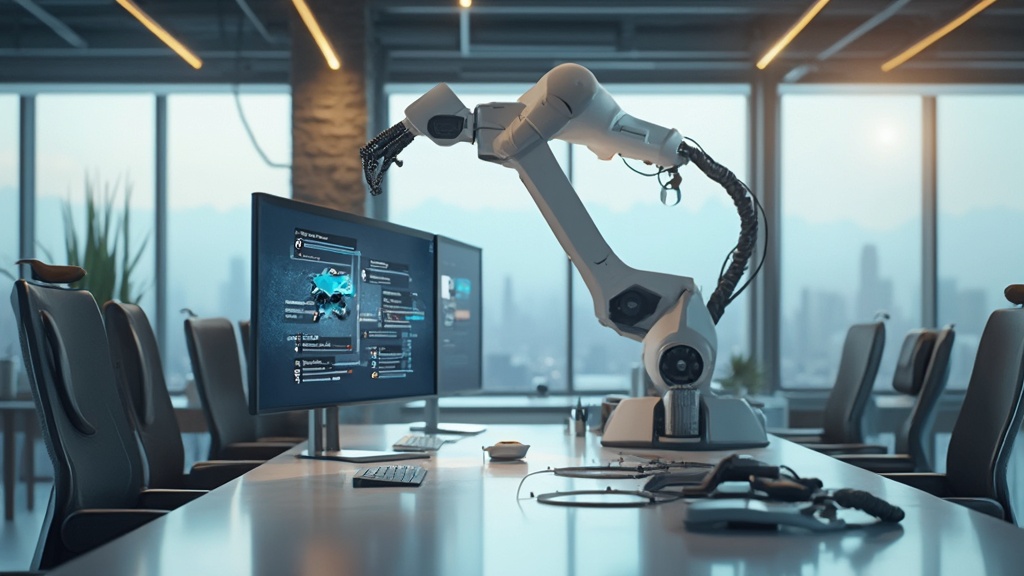Introduction
The world of automation has undergone a remarkable transformation, evolving from simple mechanical aids in ancient civilizations to the sophisticated, AI-driven systems of today. This journey began in earnest during the Industrial Revolution, which revolutionized production processes and laid the groundwork for future innovations. The 20th century saw the advent of programmable logic controllers (PLCs), further enhancing manufacturing capabilities.
In the modern era, the digital revolution has brought about intelligent automation systems that integrate AI, enabling unprecedented levels of efficiency and adaptability across industries.
Today’s landscape is defined by the convergence of traditional manufacturing with cutting-edge technologies under the banner of Industry 4.0 or smart manufacturing. This fusion is not only reshaping production processes but also demanding a new set of skills from the workforce, emphasizing the importance of continuous learning and adaptation. As intelligent automation systems evolve, they blur the lines between various categories, reflecting the dynamic nature of technological advancements.
The rapid growth of AI and digital technologies has revitalized markets that were previously stagnant, contributing to significant economic gains. For instance, the US manufacturing sector has experienced a resurgence, driven by the integration of these advanced systems, leading to higher shareholder returns and a more competitive market landscape. This acceleration marks the advent of the Fourth Industrial Revolution, promising enhanced performance, inclusivity, and sustainability.
As organizations navigate this evolving terrain, they must stay abreast of ongoing advancements to maintain their competitive edge and fully harness the potential of intelligent automation.
Historical Development of Automation
Automation has evolved significantly from its early roots in ancient civilizations, where simple mechanisms like levers and pulleys were employed to ease human labor. The Industrial Revolution marked a pivotal moment, ushering in an era of mechanization that transformed production processes. The 20th century introduced additional progress with the arrival of programmable logic controllers (PLCs) in manufacturing, paving the way for more advanced control mechanisms. ‘The digital boom of the late 20th century transformed mechanization, enabling complex programming and integration across various industries.’.
In today’s environment, automated processes are widely classified into conventional and smart categories. Intelligent technology, which is the focus of current advancements, includes AI-augmented, autonomous, autonomic, and cognitive systems. These types of automation reflect different levels of sophistication in how AI interacts with human activities and the environment. Industry 4.0, often referred to as smart manufacturing, signifies the merging of conventional manufacturing with advanced innovations. This integration is reshaping the manufacturing workforce, underscoring the need for training to stay competitive in this new era.
‘The rapid expansion of AI and digital advancements has revitalized markets that once faced stagnation.’. For instance, the US manufacturing sector, which had only grown at 1.4 percent over two decades, has seen a resurgence, with industrial companies generating higher shareholder returns over the past five years. This trend is part of the accelerating pace of the Fourth Industrial Revolution, which promises next-level performance, workforce inclusivity, and sustainability. As organizations continue to adapt, the boundaries between different categories of intelligent automation frameworks remain fluid, reflecting ongoing advancements and the dynamic nature of these technologies.
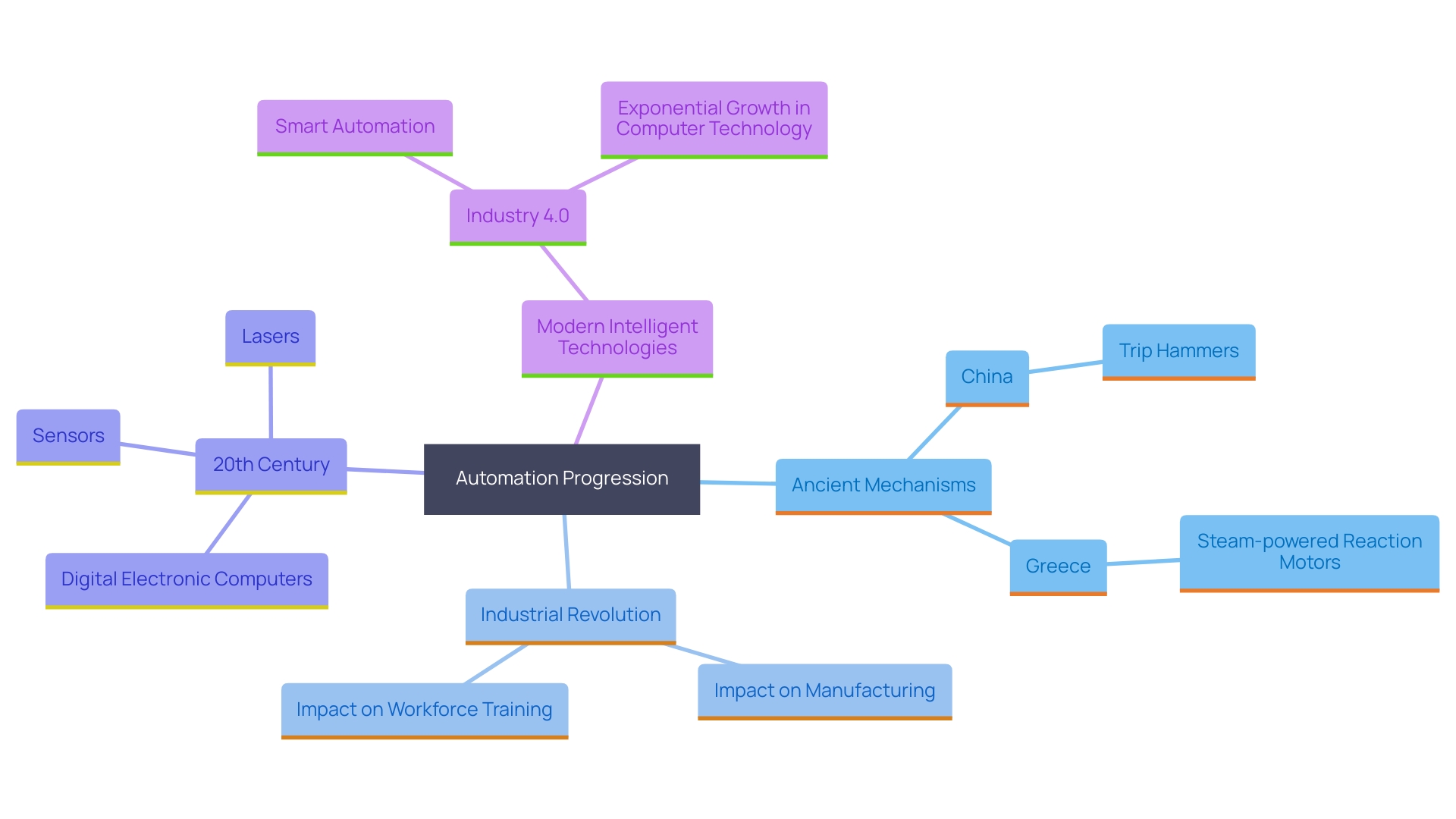
Principles and Theory of Operation
Automation fundamentally depends on control theory principles, utilizing algorithms and feedback loops to streamline processes. These arrangements function based on established guidelines and reasoning, enabling them to carry out tasks with minimal human involvement. Essential components include sensors that collect data, actuators that execute actions, and controllers that process information and direct operations. Together, these elements create efficient, reliable structures capable of adapting to changing conditions.
One example of the importance of automation is demonstrated in online simulation for industrial environments, which plays a critical role during the design and commissioning phases. As emphasized in a systematic review by Darius Deubert and colleagues, online simulation is essential for monitoring, predictive analysis, and decision support. This method enables real-time optimization and offers a wide variety of applications, improving efficiency.
Moreover, in the domain of cyber-physical networks (CPS), dynamic risk management is essential. According to a study by Daniel Schneider and co-authors, CPS must handle environmental uncertainties, such as adverse conditions and malicious attacks. Incorporating methods for smooth degradation and recovery guarantees that operations uphold safety and functionality, even during unforeseen occurrences.
The area of mechanization keeps progressing with developments in AI and machine learning, as observed in recent sector updates from Automation.com. ‘These innovations are essential for keeping operations running smoothly and efficiently, ensuring that systems can self-adapt and optimize in real time.’.
In summary, automation’s reliance on control theory, coupled with advancements in simulation and AI, underscores its significance in modern industrial environments. These innovations not only improve efficiency but also guarantee resilience and adaptability in the face of changing conditions.
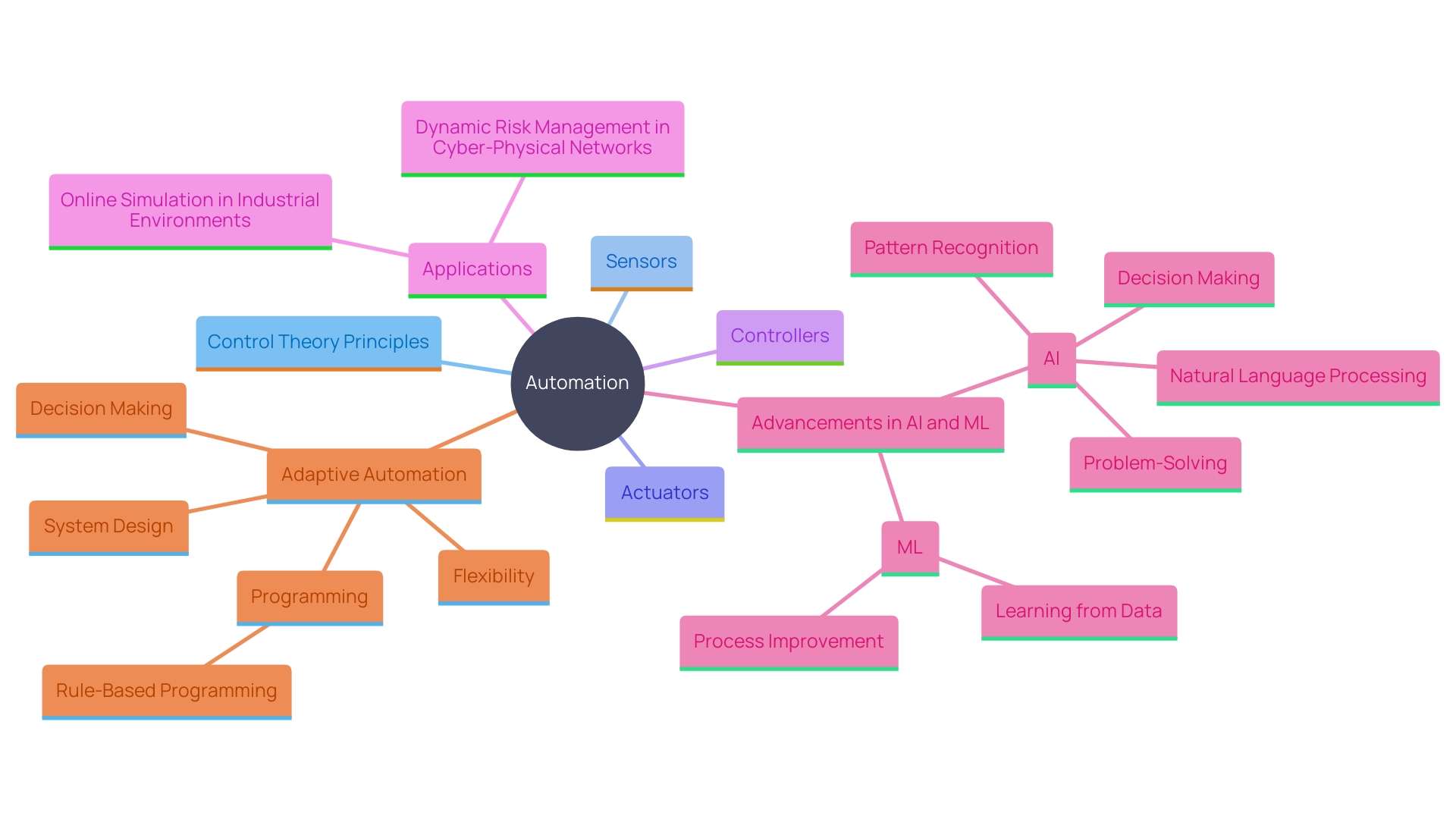
Applications of Automation
Automated computer programs are revolutionizing various sectors, including manufacturing, healthcare, finance, and logistics. In manufacturing, the integration of AI and digital technologies has significantly boosted productivity. For example, US industrial firms have observed total shareholder returns rise by approximately 400 basis points during the last five years, due to progress in mechanization. Companies like Europris in Norway have set exemplary standards by consolidating six warehouses into one efficient automated logistics center, featuring 65,000 pallet locations and 11 Vectura pallet cranes.
In healthcare, automated systems enhance operational efficiency by managing patient records, dispensing medication, and aiding in diagnostics. This is crucial as AI adoption is still in its early stages but shows promise in predictive analytics and other applications.
Financial institutions utilize technology for transaction processing, fraud detection, and risk management. These developments are part of a broader trend where AI and machine learning are becoming essential tools for optimizing performance.
Logistics companies benefit from automated solutions for route optimization, warehouse management, and supply chain operations. Europris’s journey with Swisslog to create an automated central warehouse exemplifies how mechanization can streamline logistics, thereby reducing operational costs and enhancing efficiency.
The increasing pace of the Fourth Industrial Revolution (4IR) is not only enabling next-level performance but also fostering inclusivity and sustainability in the workforce. As the landscape continues to evolve, staying abreast of these advancements is crucial for maintaining a competitive edge.
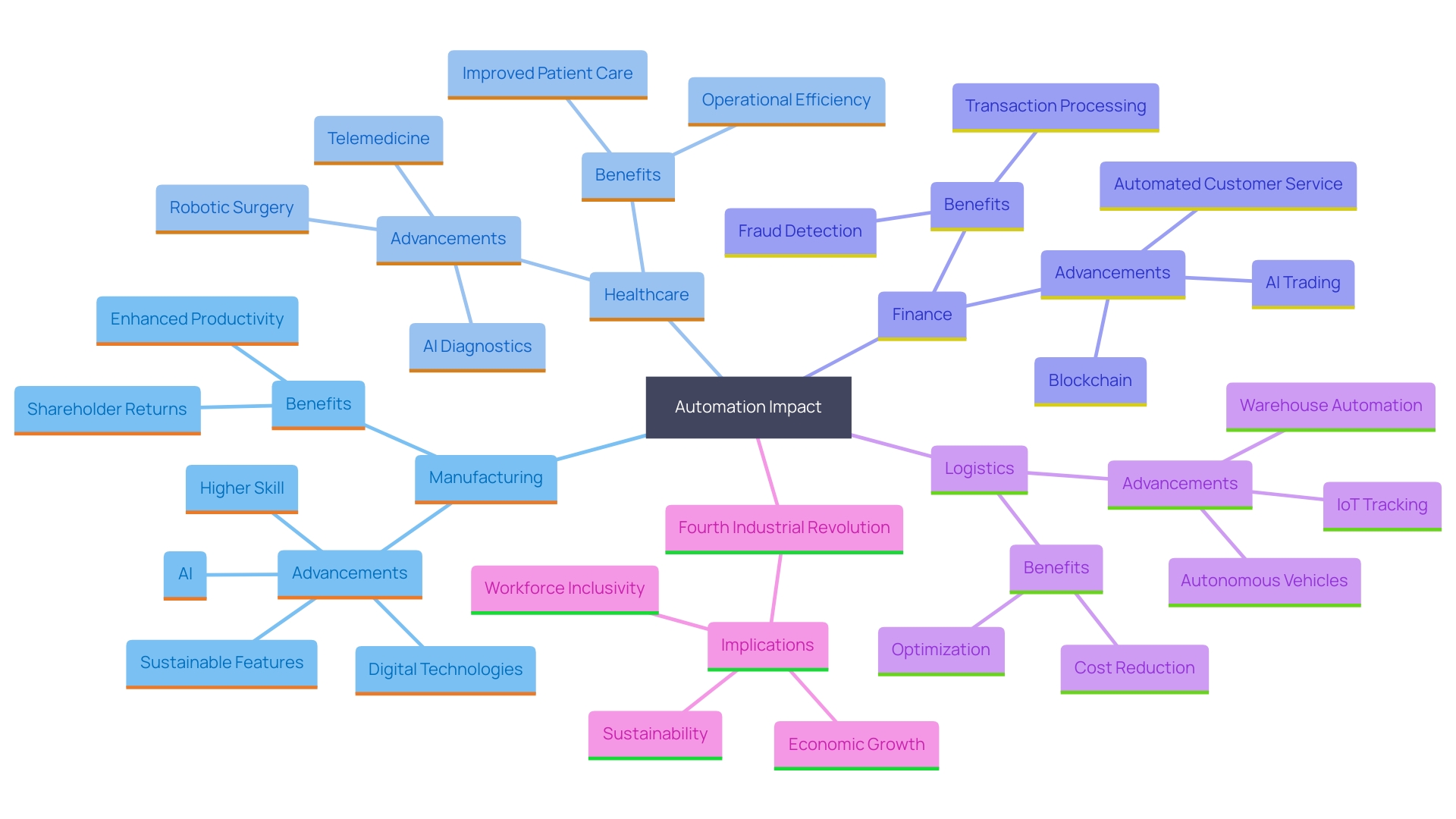
Benefits of Automation
The execution of mechanization yields a plethora of benefits, substantially enhancing efficiency, reducing operational costs, and improving accuracy. According to the International Federation of Robotics, the deployment of industrial robots has surged to around 3.5 million units globally, with a total value of 15.7 billion US dollars, particularly impacting the automotive and electronics sectors. This trend highlights the transformative change that technological advancement has brought to various sectors.
By automating repetitive tasks, organizations can free up human resources for more strategic roles, thereby fostering innovation and growth. Automation minimizes errors that often arise from manual processes, which significantly improves overall quality. For instance, the service sector has experienced significant expansion in mechanization through the use of chatbots, virtual assistants, and Internet of Things (IoT) devices, further emphasizing its crucial role in modern business activities.
Furthermore, mechanization allows for swift scaling of operations, enabling companies to react more effectively to market demands and uphold a competitive advantage. The combination of AI and technology not only boosts productivity and problem-solving abilities but also offers chances for efficiency and innovation. However, this progress does come with its own set of challenges, including workforce stability and employment displacement, which need to be navigated thoughtfully to optimize human potential and ensure equitable growth in the evolving technological landscape.
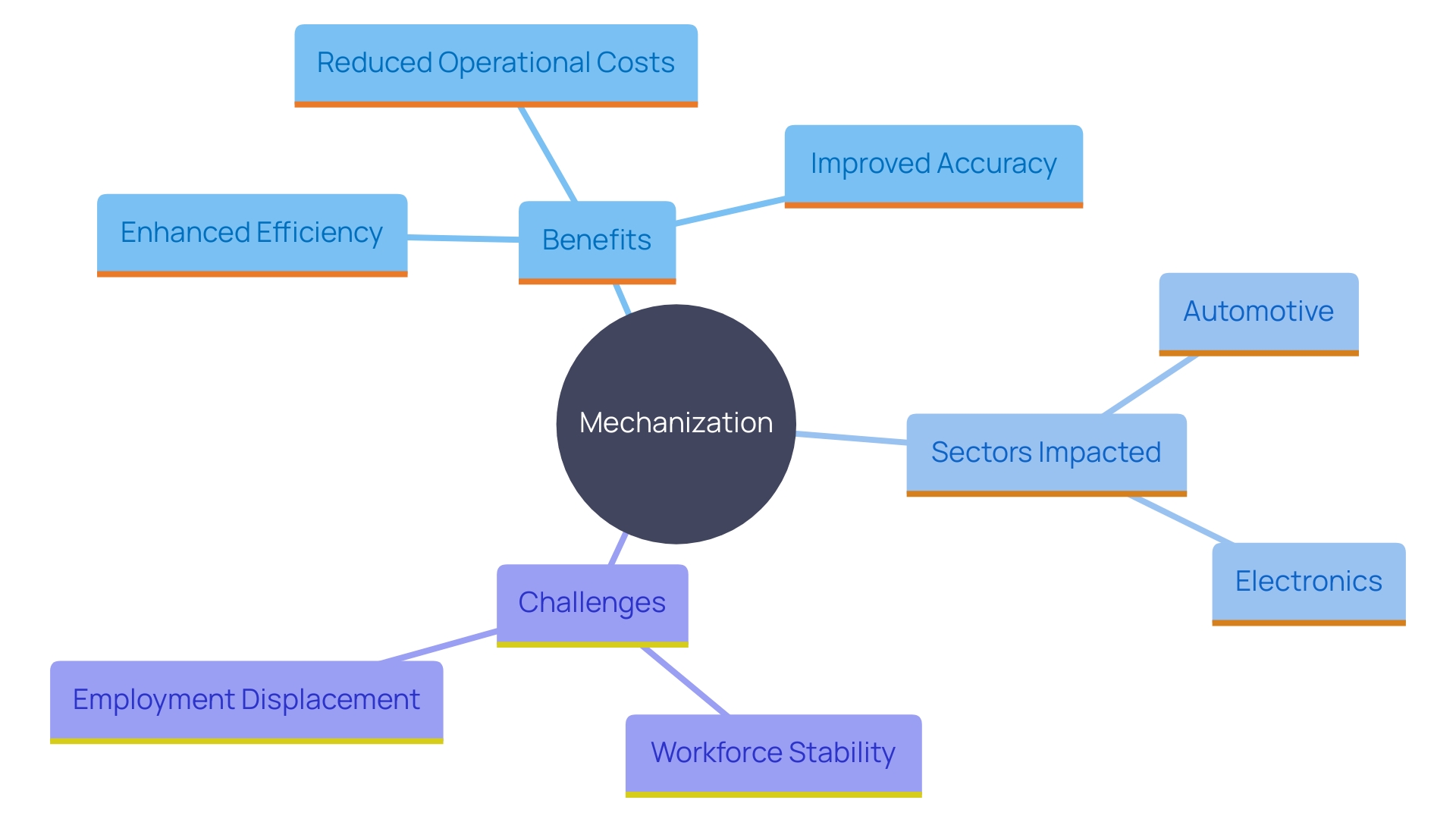
Future of Automation and AI
The future of mechanization is set for remarkable advancements, especially with the integration of artificial intelligence (AI). As AI technologies progress, automated processes will become more refined, able to learn from information and make independent choices. This will result in more flexible and responsive technological solutions, transforming business models and creating new opportunities.
Renault, for instance, has seen significant improvements in its supply chain through digitalization. By creating a data lake and pouring all supply chain data into it, Renault has developed a control tower connected to partners like Shippeo. This framework enables accurate management of factory resources, illustrating how AI-powered technology can transform processes.
John Deere’s innovations in AI and machine learning have similarly transformed agricultural efficiency, helping farmers tackle challenges like changing weather and limited arable land. This evolution in automation systems is categorized into AI-augmented, autonomous, autonomic, and cognitive, each representing varying levels of AI interaction with human activity and the environment.
The AI market is projected to reach $305.90 billion by 2024, with an annual growth rate of 15.83%, highlighting the rapid growth and investment in this field. Key players like Google, IBM, and Microsoft are driving advancements in areas such as natural language processing, computer vision, and machine learning. These technologies are not only enhancing personalization and predictive analytics but also improving human-machine collaboration, paving the way for innovative solutions across industries.
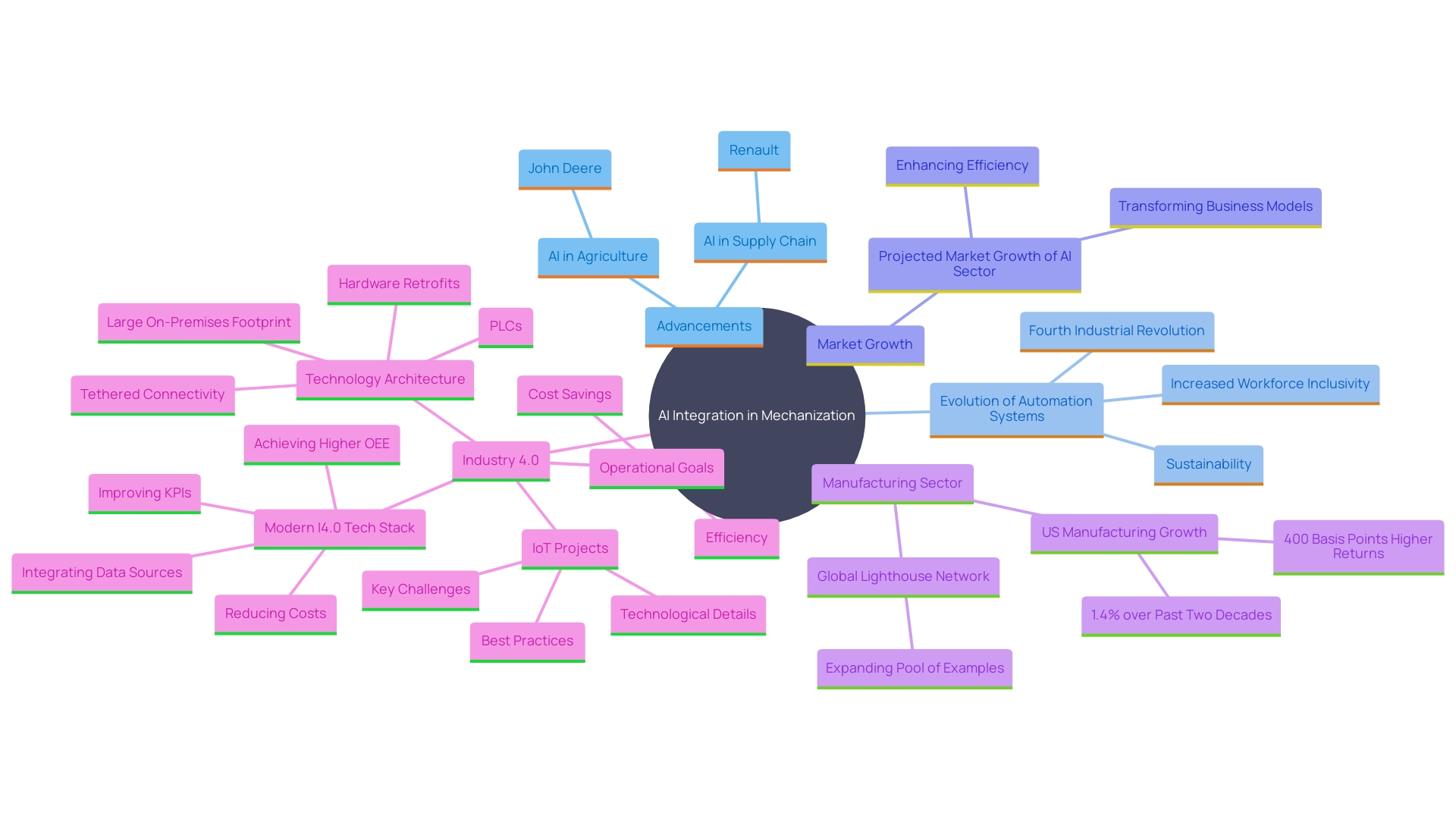
Impact on Society and Workforce
The growth of mechanization and AI has ignited broad conversations regarding its complex effects on the workforce and society as a whole. ‘While certain sectors may experience job displacement, AI and mechanization also pave the way for new roles focused on managing and developing these advanced systems.’. ‘Historical trends in productivity growth, driven by technological progress, suggest that AI could yield an increase in productivity ranging from 8% to 36%, depending on the adoption rate and application within various industries and cities.’.
Upskilling and reskilling initiatives are essential to prepare the workforce for this evolving landscape. Studies have shown that productivity improvements can lead to higher compensation and tax revenue, thereby enhancing economic well-being and standards of living. The demand for occupations such as health professionals and STEM-related roles is predicted to grow by 17% to 30% between 2022 and 2030, highlighting the importance of equipping the workforce with the necessary skills.
AI’s integration into high-skilled jobs offers both risks and opportunities, particularly for advanced economies. As we navigate this transformative era, it is crucial to address the ethical considerations and societal impacts of mechanization. This includes ensuring that human rights and ethics remain at the forefront of technological regulation. By doing so, society can harness the benefits of improved efficiency and productivity, ultimately driving economic growth and advancements in quality of life.
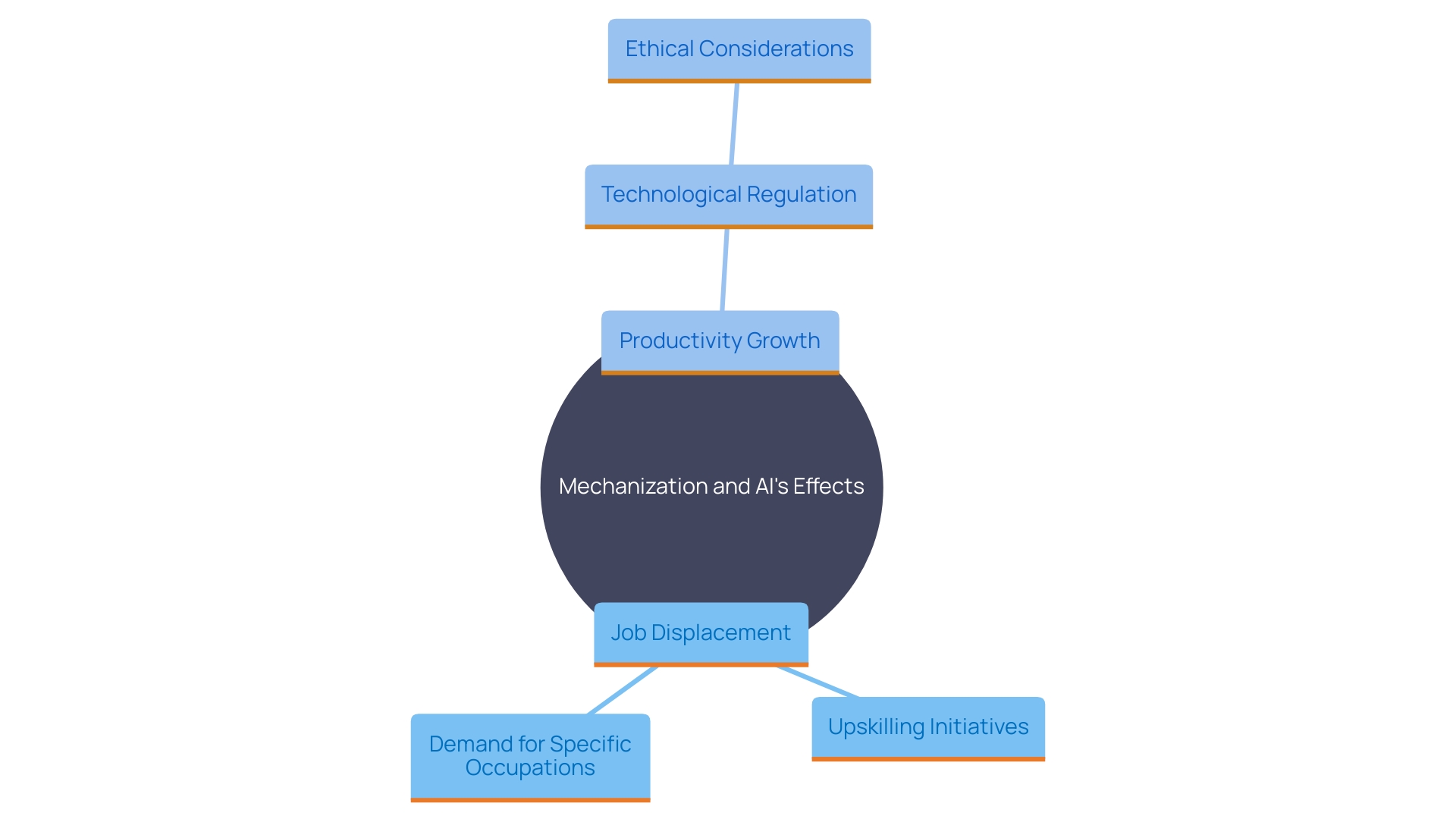
Examples of Automated Systems
Automation applications span a wide array of industries, showcasing its transformative potential. Robotic Process Automation (RPA) has become essential in administrative functions, streamlining routine tasks like data entry and report generation. In the manufacturing sector, the use of industrial robots has surged, with around 3.5 million units deployed globally, particularly in the automotive and electronics sectors, as reported by the International Federation of Robotics. Collaborative robots, or cobots, work alongside human operators, significantly enhancing productivity and efficiency.
In the service sector, the influence of mechanization is equally profound, marked by the rise of chatbots, virtual assistants, and Internet of Things (IoT) devices. These technologies are transforming customer service and operational efficiency, emphasizing the crucial role of mechanization in our daily interactions with technology. As per studies released on Statista, the worldwide industrial control market is anticipated to attain $265 billion by 2025, increasing from $175 billion in 2020.
Smart home devices, such as thermostats and security systems, further exemplify the adaptability of technology. These devices automate everyday tasks, improving convenience and energy efficiency for homeowners. The prevalence of mechanization in today’s world is undeniable, extending beyond specific industries to become an integral part of our everyday lives. A McKinsey study indicates that firms globally will allocate over 25 percent of their resources to mechanization solutions in the upcoming years, highlighting the increasing dependence on these advancements.
Automation is not just a trend but a transformative shift that continues to shape our economy and workforce. As Claire Fallon, CEO and executive director of the International Society of Automation (ISA), stated, “Global economic growth is tied closely to the successful implementation of technology and the skilled workforce to put these innovations in place.” The advancements in automation and artificial intelligence (AI) are set to further expand the possibilities, making it an essential element in enhancing various aspects of life and business.
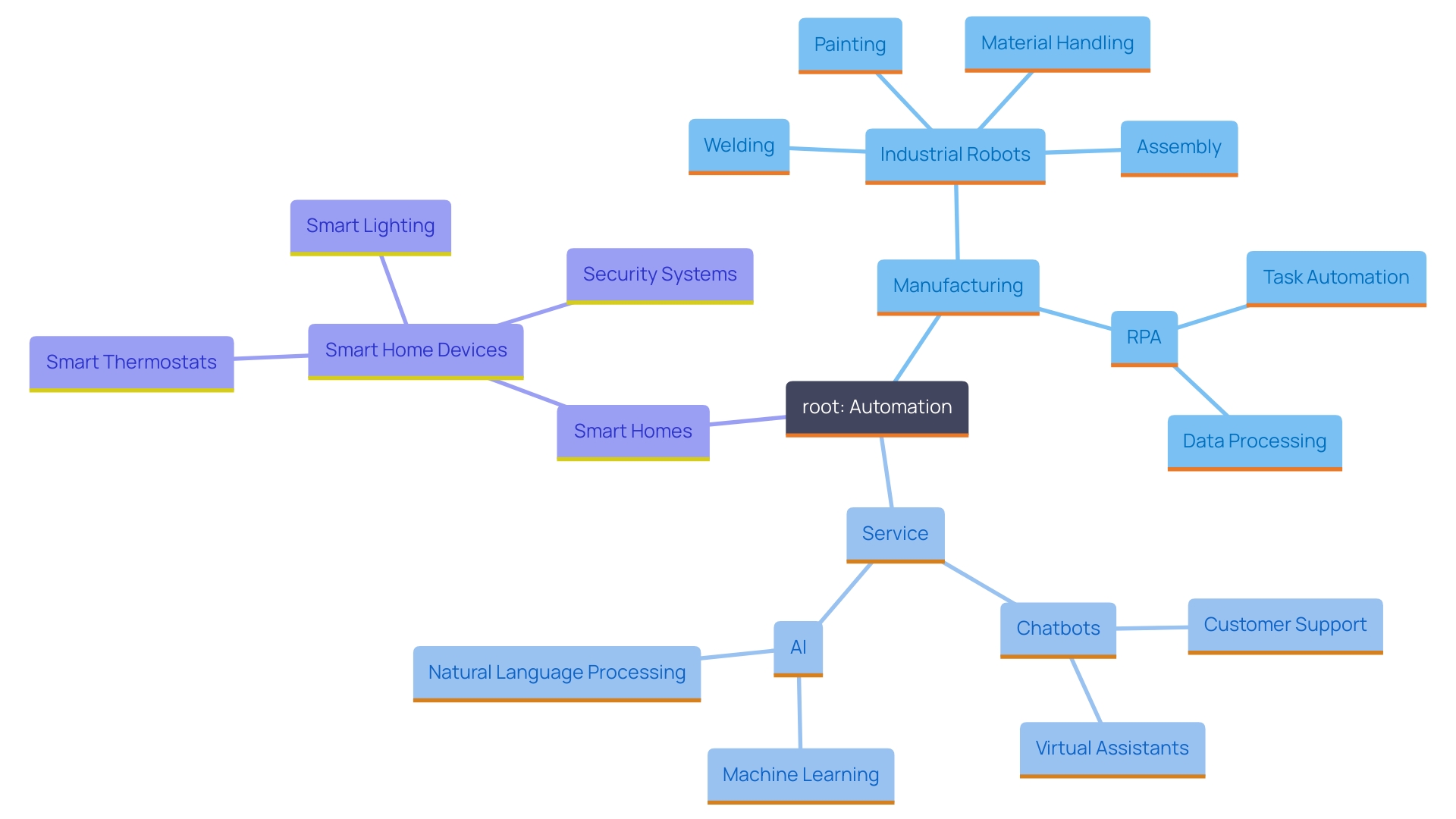
Conclusion
The evolution of automation has reached a pivotal point, highlighting its significance across various industries. From its humble beginnings with simple mechanisms to the sophisticated AI-driven systems of today, automation has transformed production processes, enhanced efficiency, and revitalized stagnant markets. Organizations that embrace intelligent automation are not only improving their operational capabilities but are also fostering a culture of continuous learning and adaptability within their workforce.
The benefits of automation extend beyond mere productivity gains; they include improved accuracy, reduced operational costs, and the ability to scale operations rapidly. As industries like manufacturing, healthcare, and logistics adopt automated solutions, they are witnessing substantial improvements in performance and efficiency. The integration of AI technologies is further driving this transformation, allowing for real-time optimization and adaptive responses to changing conditions.
Looking ahead, the future of automation is promising, with AI set to play a central role in developing more sophisticated systems. As businesses navigate this landscape, prioritizing upskilling and reskilling initiatives will be essential to prepare the workforce for new roles and responsibilities. By addressing the ethical implications and ensuring equitable growth, organizations can harness the full potential of automation, ultimately driving economic progress and enhancing quality of life for society at large.

